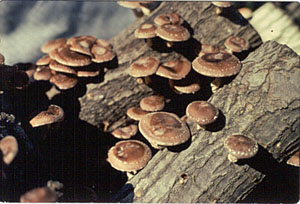Couple Farms Herbs and Mushrooms Under Managed Forest

By Mariah Cornwoman, Twin Tails Farm, Tonasket, WA
Even before we purchased our property, we had a checklist of environmental parameters that we were looking for. We wanted a piece with a number of small environmental niches and species diversity. We wanted both conifer and hardwood species in the forest. We have a perennial, spring-fed creek that runs on the diagonal across our land. We have ponderosa pine and open sage on the dry, southwest-facing slope. We have Douglas fir and tamarack with fescue meadows on the moist, northeast-facing slope. And there are several deciduous species including aspen, douglas maple and water birch along the riparian zone of the creek, with a number of small benches outside the no-cut zone.
We have about 4 acres of previously farmed ground, that we will use to grow more "domesticated" herbs. This will be the only open-field, ag-style farming practices on the farm.
We have a list of about 25 medicinal herb species we would like to introduce. There are several species that are native that we wild harvest for market, such as Oregon grape, nettle, yarrow, St. John's Wort, mullein, Wood's Rose hips and Soloman's Seal.
We currently have a patch of American Ginseng and goldenseal that seem to be doing well and we plan to expand that planting. We also have a few cascara, but they are small yet. They seem to do well and are planted in light shade (about 30%).
The shiitake mushrooms have done the best in terms of investment return and consistency of production. We plan to expand, as market orders couldn't be filled this year with our current level of production.
I wrote the Forest Management Plan, a requirement in rural Washington for maintaining our low timberland tax rate. I conducted a botanical survey, including a designation of thinning, planting and fire fuel reduction areas. We only have about 8 acres of the 40 that require thinning. However this is more for forest health than for light requirements for our crops. Since we only get about 10-12 inches of precipitation per year, establishing new plantings is a more difficult task. We are also in an area that gets annual forest fires from dry lightning strikes, so elimination of ladder fuel is actually top of the list for forest practices. Between this and proper tree spacing, we generally have 50 to 70% shade. This meets the requirement for shiitake and most herb production. We have an intermediate layer as well. This consists of wild currant, Woods Rose, elderberry, serviceberry and saskatoon, all of which provide excellent feed for wildlife and reduce potential feeding on crops.
Here in the West, we of course contend with open range cattle. The law requires that we fence them out, even on private property. So as an herb farmer, I've strung a lot more barbed wire than I ever wanted to. But the native grasses and wildflowers are rebounding now that we've got them off, and I'm not dodging cow patties on the forest trails anymore.
In terms of marketing, we plan to certify our crops as organic. Infrastructure will include our own post-harvest processing facility, and spore culture lab for the mushrooms, to capture some of the value-added dollar. We are currently exploring some grant options to form a growers marketing cooperative with several other local farmers in the area.
We are proud to be developing a new model of ecosystem management in a region that has been a resource-based economy for over 100 yrs. (timber/mining/ag). We hope to find a balance that creates both a healthy, diverse forest ecosystem and the producer who wants to make a living from the land.

